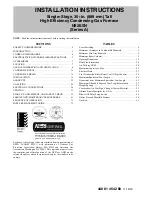
17
INSTALLATION CONSIDERATIONS
HORIZONTAL APPLICATIONS AND CONSIDERATIONS
Horizontal applications, in particular, may dictate many of
the installation’s specifics such as airflow direction, duct-
work connections, flue and/or combustion air pipe connec-
tions, etc. The basic application of this furnace as a hori-
zontal furnace differs only slightly from an upright installa-
tion.
H
ORIZONTAL
I
NSTALLATIONS
1. Horizontal installations require 5.5" under the furnace to
accommodate the drain trap.
2. Horizontal furnaces must be installed with ¾” slope from
back to front to permit condensate flow towards the front
of the furnace.
When installing a DM96VE horizontally with the left side
down, there are two options for connecting the vent pipe to
the furnace.
1. Venting may be connected to the furnace vent pipe fit-
ting on the original top (now the end) of the furnace
2. The internal vent pipe and elbow may be removed from
the furnace to permit the vent to exit the top (original
side) of the furnace. If this option is used, an RF000142
Vent-Drain coupling must be used to keep condensate
from collecting in the inducer assembly
Refer to the following instructions and illustration.
Insert flange. Cut 2 ½” long.
R 000142
F
Vent/Flue Pipe Cuts
1. Remove screws from the vent flange.
2. Remove the internal elbow and vent pipe
3. Cut 2 1/2" from the flange .
4. Remove cabinet plug adjacent to inducer outlet and in-
stall an original cabinet vent hole.
5. Install RF000142 coupling on inducer outlet.
6. Install flanged vent section removed in step 2 and se-
cure with clamps.
7. Secure flange to cabinet using screws removed in step1.
D
RAIN
T
RAP
AND
L
INES
In horizontal applications the condensate drain trap is se-
cured to the furnace side panel, suspending it below the
furnace. A minimum clearance of 5.5" below the furnace must
be provided for the drain trap. Additionally, the appropriate
downward piping slope must be maintained from the drain
trap to the drain location. Refer to
Condensate Drain Trap
and Lines
section in this manual or the installation instruc-
tions for further details. If the drain trap and drain line will be
exposed to temperatures near or below freezing, adequate
measures must be taken to prevent condensate from freez-
ing.
NOTE:
The use of insulation and/or heat tape is recom-
mended. Failure to provide proper condensate drainage can
result in property damage.
L
EVELING
Leveling ensures proper condensate drainage from the heat
exchanger and induced draft blower. For proper flue pipe
drainage, the furnace must be level lengthwise from end to
end. The furnace should also be level from back to front or
have a slight tilt with the access doors downhill (approxi-
mately 3/4") from the back panel. The slight tilt allows the
heat exchanger condensate, generated in the recuperator
coil, to flow forward to the recuperator coil front cover.
















































